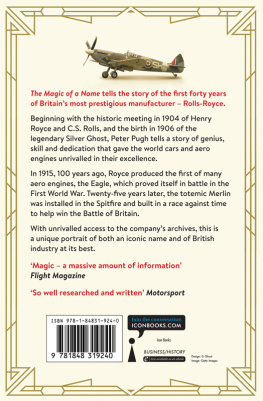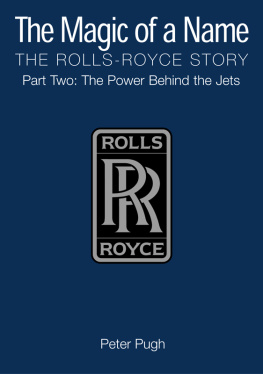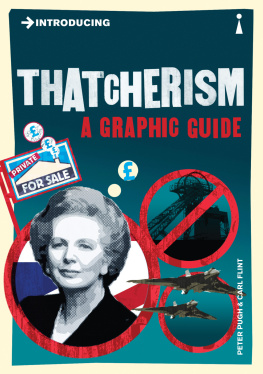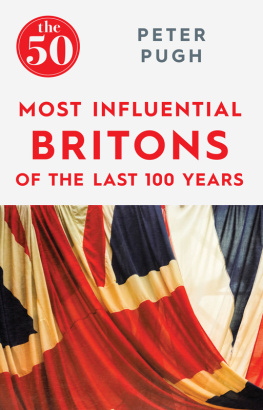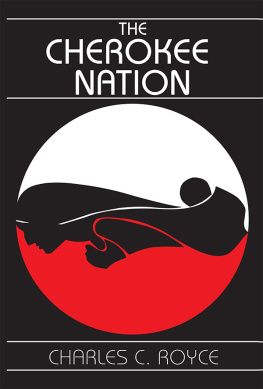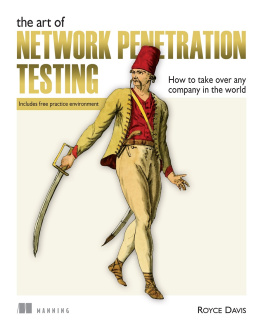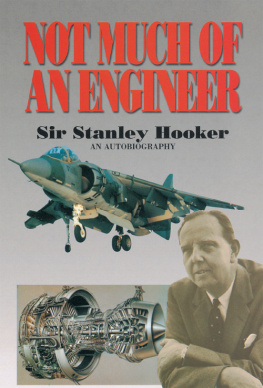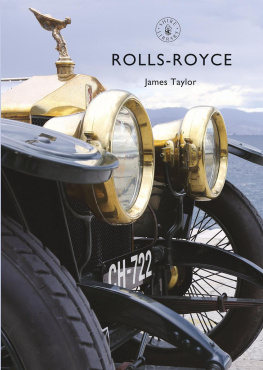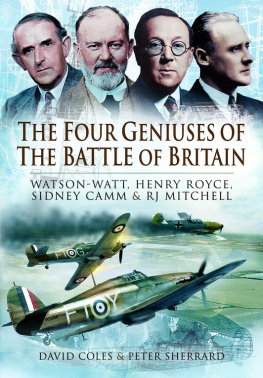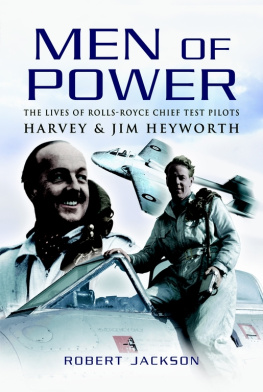ROLLS-ROYCE
THE MAGIC OF A NAME
I was fortunate enough to make the acquaintance of Mr. Royce and in him I found the man I had been looking for for years.
The Hon. C.S. Rolls
I not only admired him, I was one of the few people who were genuinely fond of him Henry Royce ruled the lives of the people around him, claimed their body and soul, even when they were asleep.
Ivan Evernden
Everyone who rode with Rolls testifies to the quickness of his reaction, and to the sensation that he was at one with his steed.
Lord Montagu of Beaulieu
The real genius responsible for the wide fame of the Rolls-Royce car is C.J.
Lord Birkenhead
I can say with all sincerity that those who are best able to judge would put you among a very few men whom the country has to thank above all others for our survival in this war.
Air Chief Marshal Sir Charles Portal
[in a letter to Ernest Hives]
ROLLS-ROYCE
THE MAGIC OF A NAME
THE FIRST FORTY YEARS OF BRITAINS
MOST PRESTIGIOUS COMPANY
Peter Pugh

This edition published in 2015 by
Icon Books Ltd, Omnibus Business Centre,
3941 North Road, London N7 9DP
email:
www.iconbooks.com
First published in 2000 by Icon Books Ltd
Sold in the UK, Europe and Asia
by Faber & Faber Ltd, Bloomsbury House,
7477 Great Russell Street,
London WC1B 3DA or their agents
Distributed in the UK, Europe and Asia
by TBS Ltd, TBS Distribution Centre, Colchester Road,
Frating Green, Colchester CO7 7DW
Distributed to the trade in the USA
by Consortium Book Sales and Distribution
The Keg House, 34 Thirteenth Avenue NE, Suite 101,
Minneapolis, MN 55413-1007
Distributed in Canada
by Publishers Group Canada,
76 Stafford Street, Unit 300
Toronto, Ontario M6J 2S1
Distributed in Australia and New Zealand
by Allen & Unwin Pty Ltd,
PO Box 8500, 83 Alexander Street,
Crows Nest, NSW 2065
Distributed in South Africa by
Jonathan Ball, Office B4, The District,
41 Sir Lowry Road, Woodstock 7925
ISBN 978-184831-924-0
Text copyright 2000 Peter Pugh
The author has asserted his moral rights.
No part of this book may be reproduced in any form, or by any
means, without prior permission in writing from the publisher.
Typesetting by Hands Fotoset, Woodthorpe, Nottingham
Design and layout by Christos Kondeatis
Printed and bound in the UK by
Clays Ltd, St Ives plc
ABOUT THE AUTHOR
Peter Pugh was educated at Oundle and Cambridge. He has written about fifty company histories, the latest being The Heart of the Matter, on Papworth Hospital in Cambridgeshire. He lives in Cambridge and Brancaster, Norfolk.
INTRODUCTION
Many books have been written about Rolls-Royce over the years. There have been nearly fifty specifically on Rolls-Royce cars or aero engines or both, and there are hundreds more which devote many words to Rolls-Royces products and their importance. However, most of these books are either biographies of the leading personalities, or works that tackle specific aspects of the cars or the aero engines.
The last publication to attempt a comprehensive history of Rolls-Royce was Harold Nockoldss The Magic of a Name, published by Foulis in 1938 and reprinted several times until a third edition was finally printed in 1972. This book is the first part of a trilogy that is the first attempt since Nockolds to cover comprehensively the story of Rolls-Royce from its earliest days until the present. The Rolls-Royce name is magic, made so by the calibre of its people and its products, and the title The Magic of a Name is singularly appropriate. Foulis, now owned by Haynes Publishing, kindly allowed us to use the title again.
When I was asked to undertake the task of researching and writing the story of Rolls-Royce I was extremely excited at the prospect. It was surely a great story. In fact, as I soon found out, it is much more than that: it is several great stories. The genius and dedication of Royce, allied to the flair for publicity of Rolls, led to the production and worldwide sales of the best car in the world, the Silver Ghost. Shortly afterwards, Royces skill as a designer quickly produced the leading aero engine of the First World War, the Eagle.
By the 1920s, Royces reputation was such that he was asked, almost ordered, by the Government to design an engine for Britain to retain the Schneider Trophy. This association with the inspired aircraft designer, R.J. Mitchell, led on to the Spitfire and Rolls-Royces Merlin engines. It is safe to say that, without the Spitfire and the Hurricane, and the Merlins that powered them, the Battle of Britain would have been lost. Finally, in this book, we look at the advent of the jet engine and how Ernest (later Lord) Hives realised its importance for the future of air travel and backed Sir Frank Whittles development to the hilt.
Rolls-Royce has become world-famous above all for the quality of its products and these have been analysed in great detail elsewhere. This book is not a technical one. It attempts to put Rolls-Royce products and Rolls-Royce people in their context. Royce and Rolls set the highest standards, and when you have read this book I think you will agree that the tradition has been carried on faithfully by all who have been lucky enough to work with them and after them in Rolls-Royce.
Peter Pugh
July 2015
The value of money
In a book about a business, we cannot ignore the changing value of money, and with the exception of the inter-war years the twentieth century was inflationary. There is no magic formula for translating 1900 prices into those of 2015. Some items have exploded in price, others have declined. We have to choose some criterion of measurement, and I have chosen the average working wage.
The Victorian age was one of stable prices, but prices started to rise just before the First World War, and rose sharply at the end of it. (Wars are always inflationary, because they distort supply and demand.) Immediately after the war, prices were more than twice as high as in 1914, and although they declined somewhat in the depressed economic conditions of the 1920s and 30s, they remained about twice as high as those before the war.
Price controls and rationing were imposed in the Second World War, but as these were withdrawn, prices again doubled. Inflation continued at about 3 per cent a year through the 1950s and 60s, but then rose sharply, almost catastrophically, in the 1970s. Although it was brought under control by the end of that decade, there were two more nasty upward blips in the early and late 1980s before the more stable 1990s.
I have used the following formula:
Late nineteenth century multiply by 120 to equate with todays prices
Early twentieth century multiply by 110 to equate with todays prices
191845 multiply by 60 to equate with todays prices
AUTHORS ACKNOWLEDGEMENTS
In researching this book on Rolls-Royce I have read all of the books mentioned in the bibliography, and quoted from several of them. I am grateful to the authors and to the publishers. I have interviewed many people, some of them several times, and I am grateful to them too. Most of the interviews took place in Britain, but I travelled to the USA several times, both to research the archives held at Gilbert, Segall and Young, Rolls-Royces legal advisers in New York, and those at Rolls-Royce Allison in Indianapolis, and also to interview a number of people who had been in close contact with Rolls-Royce. I also travelled to Australia to interview a number of people there.
Next page
